[click on blue links for further information]
“Long ago my grandfather used a Canoe to cross the bay from Pizota to Sayulita or to Vallarta to sell it.” Muriel Castillon
I first tasted Raicilla in 2010. I was spending a few days with my family at Mismaloya beach, the site where The Night of the Iguana was filmed in 1963. I’d been there before. I’d heard about the local hooch that fortified Richard Burton and John Huston during the filming of the movie. I was anxious to try it.
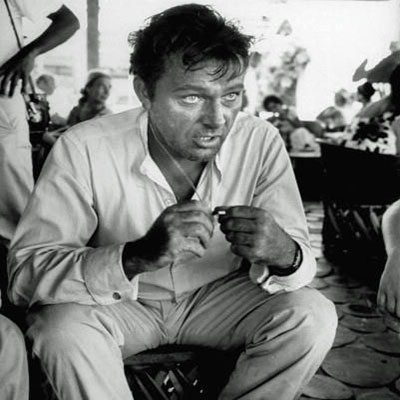
Richard Burton

John Huston
A friendly waiter said he could buy a bottle at the ranch where it was made nearby and bring it to me. I knew nothing about Raicilla at the time, so I said yes. On the first try, the resort manager confiscated the Raicilla before it could be delivered. The manager frowned on the staff mingling too closely with the guests. The second try was successful.
That first bottle was a great disappointment. I told my friend Gil Gevins who with his wife Lucy owns Lucy’s CuCu Cabana on Basilio Badillo street in Puerto Vallarta : “That Raicilla tasted like it was made in an old gasoline can that hadn’t been cleaned out.
“It probably was,” said Gil. Gil is well known for his humorous articles in the PV City Paper. “Raicilla is Mexico’s most dangerous moonshine. You should have asked me first.”
I took the bottle home with me anyway, and I managed to drink it one lethal shot after the other. Oddly enough I developed a taste for the stuff.
“Experts tell us that the ability to reason is the first thing to go in victims of Raicilla poisoning.” Gil Gevins
In the years following, I made a point of tasting as much of the firewater from the Bay of Banderas as I could get my hands on when I was in town. Once considered the drink of the poor, like Mezcal from Oaxaca Raicilla is now trendy and growing in popularity in the states and in Europe.
In the book Escape to Paradise: A Mexican Odyssey, author William Reed writes that moonshine batches of Raicilla can contain mescaline, the hallucinogenic found in peyote. Raicilla is made in different parts of the state of Jalisco with varying quality and taste. The Raicillas of Yelapa are called “raicilla de costa” and are made using several wild agaves including green and yellow. They tend to be smoky and have grassy notes. Distilling practices vary from family to family. “Raicilla de la Sierra” is made in the mountains generally using agave maximiliana (agave para de mula), also known as lechuguilla, a type of agave that only grows 6,000 feet above sea level. The flavor tends toward citrus and botanical and is much less smoky.
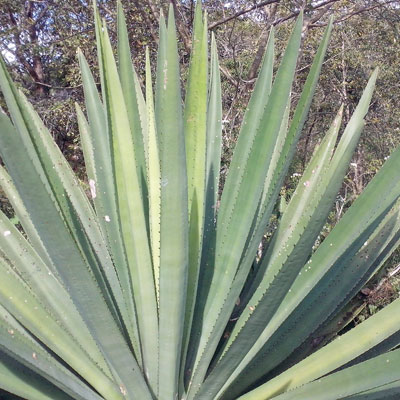
Wild Green Agave used to make Muriel’s Raicilla
In one of Gil’s articles, he describes a scene that brought to memory Graham Green’s The Power and the Glory:
The plainclothes priest took a healthy slug of Raicilla causing his throat to spontaneously combust. Then, his eyes watering with religious fervor, he reached down, grabbed my Pepsi and poured its entire contents down his scorched gullet. Then he emitted an enormous burp and said, “This is very good!”
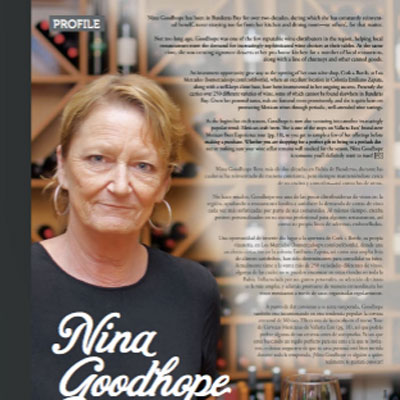
Nina Goodhope
After the Mismaloya escapade, I decided my next purchase should be planned more carefully. I found some upscale Raicilla at the Cork ‘n Bottle in Los Mercados, a complex of four shops located on Aquiles Serdan in the Zona Romantica of Puerto Vallarta. Cork ‘n Bottle is operated by Nina Goodhope, known locally as La Chica de los Vinos (see page 30 HERE). She provided tastes and information on Raicilla El Real. The distiller is located in the beautiful colonial town of San Sebastian in the mountains above Puerto Vallarta. There are three types of El Real, blanco, moderately aged, and reposado which is aged longer. All three are smooth and soft with the most refined moving up the age ladder. Some of my friends say the reposado tastes like a fine brandy. El Real boasts silver and gold medals at several local tastings. It was delicious, but I hankered for something a little less refined, hot and smoky like that first bottle I purchased but better.
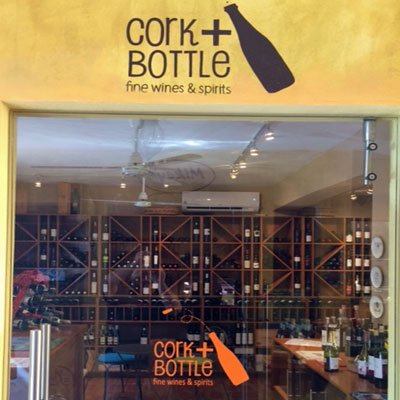
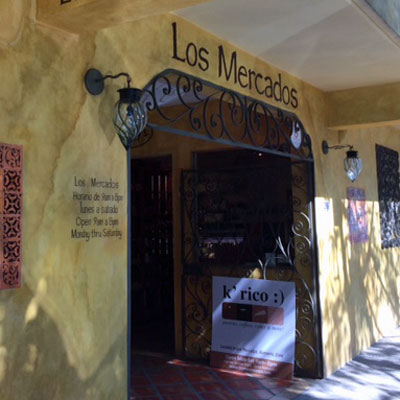
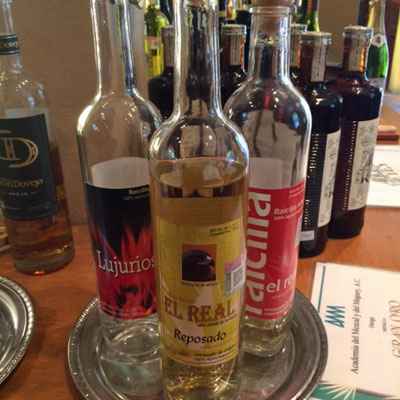
Raicilla El Real
“We use the Roble wood to bake the agave. It is plentiful and burns very hot.” Muriel Castillon
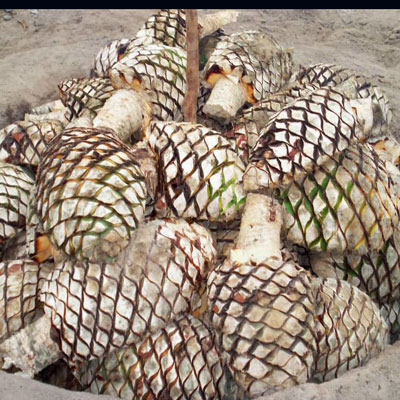
Piñas Ready to Roast
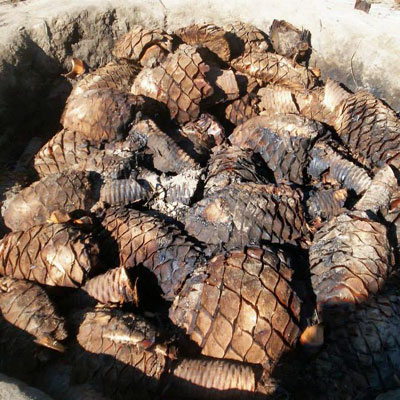
Roasted piñas
Once cooked down to a molasses texture, the agave is “smashed like grapes,” juice is pulled from within wood containers and regional spring water is added for a double distillation.
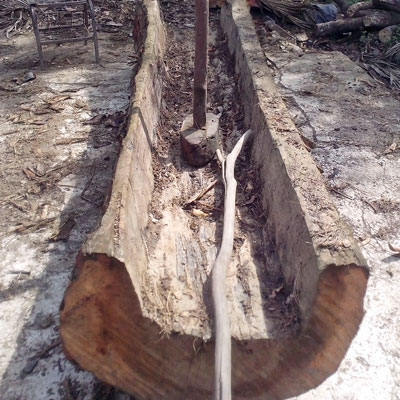
Canoe and Mazo
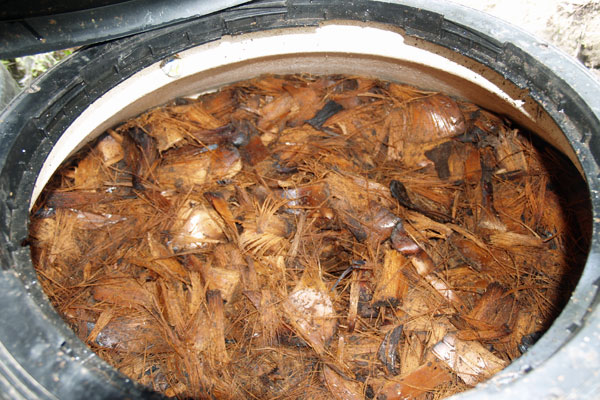
Raicilla fermenting in Tinacos
“The tinacos (covered storage tanks) is where the baked and smashed piñas are fermented. The fermentation process takes a week. We don’t use machinery. We crush the agave on the canoe (hollowed out tree trunk) with a majo (heavy, hand-hewn mallet, also called mazo). Then we put it in a water tank and let it get warm by itself. Last, depending on the water and the sweetness of the agave, we distill twice. The first distillation we call Ordinario and the second is called Raicilla. To check the quality we use two Casuals (gourd cups formed by cutting the cuastecomate fruit in half and removing the seeds and pulp). The Raicilla is emptied back and forth from one cup to the other to see if bubbles form. When bubbles are formed, the Raicilla is ready.” Muriel Castillon
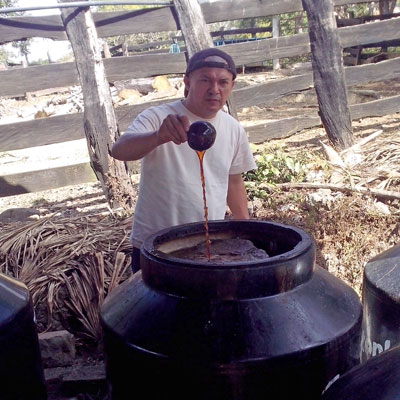
Testing the batch
Several fine Raicillas are made at or near San Sebastian. I tasted Raicilla El Parral at Chile Tequila while walking along the Malecon. I told the salesman it was smooth and citrusy but not very smoky. It was similar but not as good as the El Real. He said the “raicilla de la sierra” is less smoky because the agave is cooked above ground while the “raicilla de costa” is cooked in underground pits where the smoke permeates the piñas. He sold only Raicilla El Parral because it was bottled legally. He said if I preferred the smoky variety he had some water bottles filled a local Raicilla made by his friends in El Tuito. He offered me a taste and poured himself a taste to share with me. I think he wanted to assure me that it was safe to drink. It was very smoky and burned as it passed through my throat into my chest. I was close to what I was looking for and was half the price of the El Parral. He explained that I couldn’t take it to the states “legally” because it was not stamped and licensed. I thanked him. I wasn’t ready to buy yet. I was having too much fun tasting.
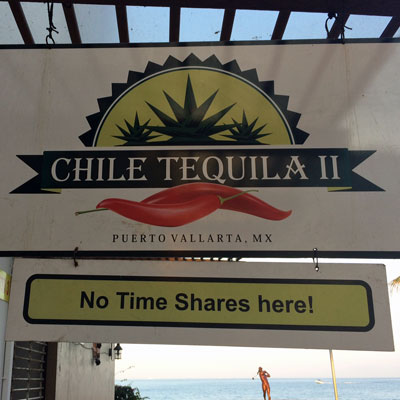
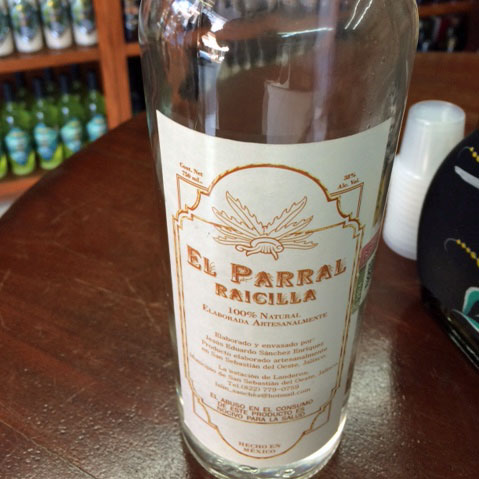
El Parral Raicilla from San Sebastian
“The name Raicilla has been used for centuries to describe the mezcal of Jalisco. It came about in the 1700s as a deception to avoid taxes on mezcal levied by the Spanish Crown.” The Rise of Raicilla by Jaimy Lee
We wandered on down to Daiquiri Dicks restaurant on Los Muertos Beach (the Beach of the Dead) where I tried Hacienda el Divisadero. This Raicilla is made at Cabo Corrientes near Yelapa. I thought it had an unusual cheesy flavor but it lacked the smoke I was looking for because it had been smoothed by aging. The bartender, Cheque, was looking suspiciously in my direction. As far as I knew, I wasn’t doing anything odd but it dawned on me that I had been sipping Raicilla all afternoon. Sipping Raicilla, particularly along the Breach of the Dead, sobers the brain while intoxicating the soul. I knew instinctively that finding a place for lunch would be the right thing to do. The look on my wife’s face confirmed this decision. I spoke as clearly and confidently as I was able. “Look, I’m not going to drink Raicilla all day long. How about some lunch?”
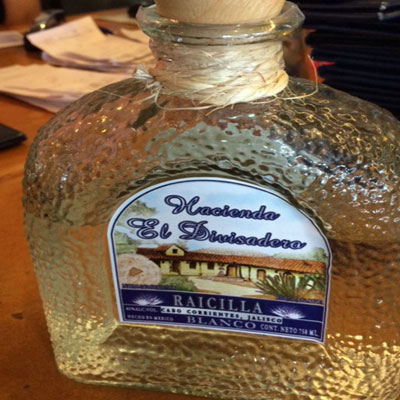
“Actually, no one could spend an entire day drinking Raicilla. I’ve seen a few people try and they all wound up doing the breaststroke – in the sand. Or getting stuck halfway up a palm tree.” Gil Gevins
We had lunched at Daiquiri Dick’s the day before, so I needed another idea. I had seen an episode on the Food Network called Beach Bites with Katie Lee whom my wife adores. They featured a place called Gaby’s up above the Malecon. As I recalled, Katie Lee had a pineapple Raicilla cocktail with lunch. Here was a way to kill two birds with one stone, or one stoned man with two birds, or something like that. My wife was charmed by the idea of eating at the same restaurant as Katie Lee.
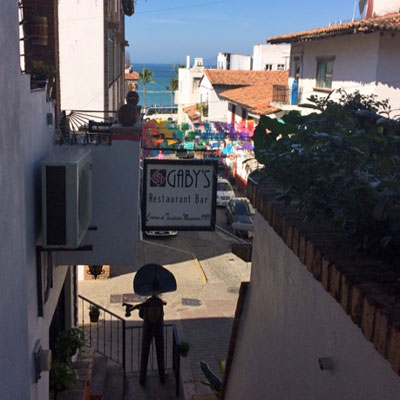
“Sometimes we make a batch with cuastecomate fruit added. Otherwise, nothing is added except water to help with the fermentation process.” Muriel Castillon
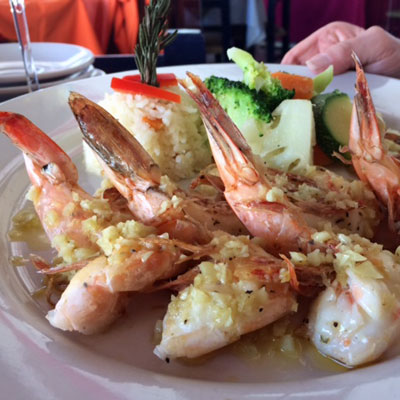
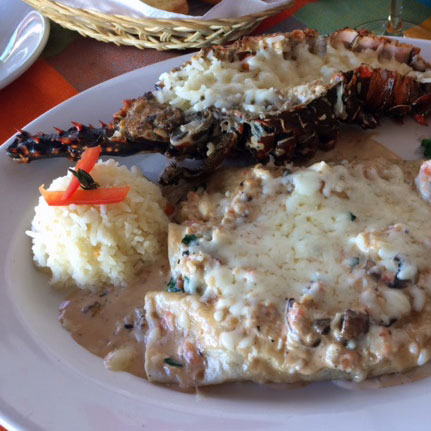
It was at Gaby’s that I met Muriel. We had an extravagant lunch of wild blue shrimp simply grilled and enchiladas made with the local spiny lobster. The word for lobster in Spanish is langosta. I love the sound of it. I say langosta whenever the opportunity arises, I motioned our waiter to the table. “La langosta era maravilloso. Do you have any Raicilla?”
Muriel’s eyes lit up and a soft smile crossed his face. “Si, Señor.” We were off and running.
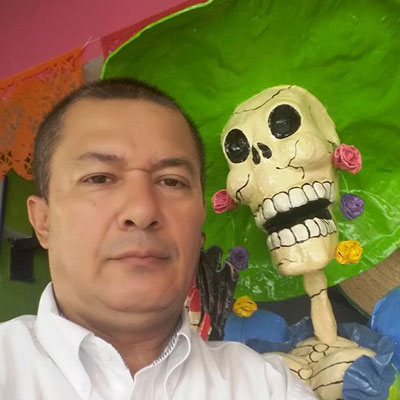
Muriel at Gaby’s
“People in the villages often use raicilla for medicinal purposes, to clear a cough or treat other ailments.” Muriel Castillon
Today the moonshine from Puerto Vallarta has suddenly become a marketable and expensive spirit sold in the U.S. at least in the areas like California and New York where Donald Trump lost the vote. In August 2014, Fidencio Spirits, an alcohol importer in New York City, began promoting La Venenosa Raicilla (article by Mezcalista HERE). It is the most widely available of Raicillas in the land of the gringos and the first raicilla to legally enter the U.S. La Venenosa, founded and curated by Chef Esteban Morales, offers Raicilla from 4 distinct areas, from different producers, agaves, equipment and terroir.
“Different weather, different soil, different minerals. You can feel all this on your tongue the moment you taste it … Sometimes, I love to taste my raicilla and I love to get drunk with it,” says Sanchez with a chuckle. He’s the proud grandson of an accomplished mezcal maker. “Because you wake up nice. It’s a natural honey. And if you do the whole process in the right away, why feel terrible the next morning?” Eduardo “Lalin” Sanchez
The gluten-free trend didn’t hurt this development either, since all mezcal, including tequila, is made from an agave mash and not grain mash like whiskey or bourbon.) Be careful though. The big corporations are already stepping in and trying to corner the industry. Jose Cuervo is importing Raicilla under the name La Crisanta into the U.S. The quality isn’t there. Sadly, I found the main liquor store in Old Town Vallarta, Vinos Amerikos, sells only La Crisanta. La Venenosa’s founder, Esteban Morales Garibi, is currently in a legal battle with Jose Cuervo. Cuervo recently launched a mezcal from Oaxaca into the Mexican market called 400 Conejos—the same name as Morales’ beloved alternative mezcal bar in Guadalajara.
“A la chingada con Cuervo,” he jokes (translation: “F**k Cuervo.”)
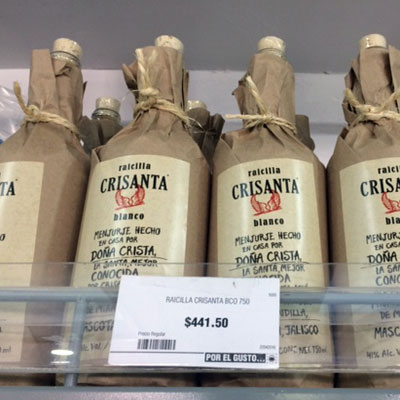
Raicilla Crisanta
I tasted Muriel’s Raicilla and I was hooked. It was smoky, both harsh and smooth, a little sweet to the tongue. I detected a bit of licorice. I thanked him for the information and promptly bought two bottles. One will never make it home.
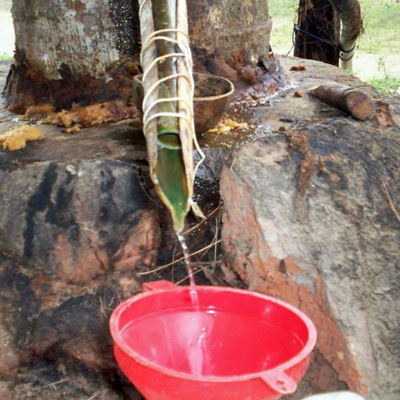
Capping the Raicilla
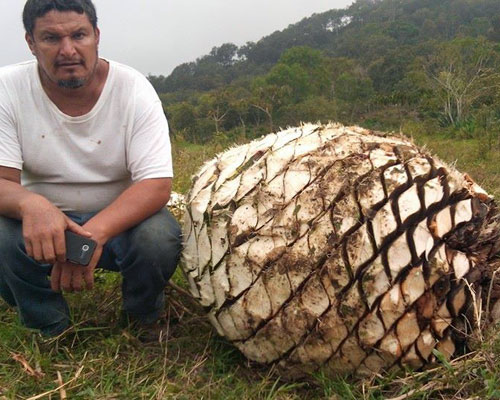
Bulichis Jimando, Muriel’s brother
So, here I am sipping on a fruity, leathery-smoked mezcal made from wild agave plants ripened under the coastal Mexican heat on a beach in Puerto Vallarta. Thus far I’m not swimming in the sand or climbing a palm tree, but the afternoon is still young and the bottle isn’t empty yet. One more thing, the shopkeepers will tell you not to buy Raicilla that hasn’t been inspected and approved by the authorities. This is for a good reason, you might get a bottle like the one I first tasted at Mismaloya and it might kill you. Probably not, but it might. However, if you feel in your heart you can trust the person you are dealing with and if the Raicilla meets your taste test, I say “Go ahead.” In the spirit of Señor Esteban Morales Garibi I say “A la chingada” with the rules. Burton and Huston survived and I have too, so far.

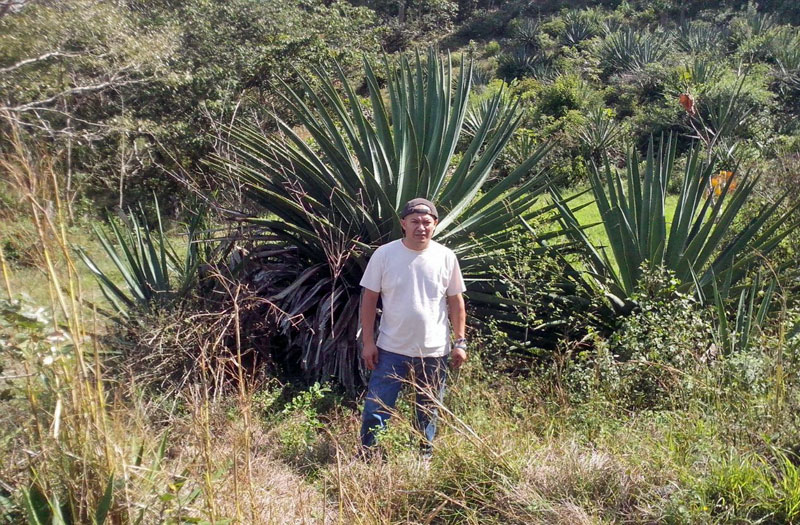
Available in Mendoland David?
Just from me. Make an appointment to see the newly painted office after Jan 10 and I’ll give you a taste.
Good grief!! If we never see you again we’ll know you’re humming under a cactus, BENDING YOUR ELBOW EVERY NOW AND THEN.. Happy New Year David.
great story david…….it sounds like retirement is totally agreeing with you!
I tried raicilla en Yelapa, back in 1990. A friend and I stayed overnight there and were given a mayonnaise jar full of the beverage to “try”. All I can say is that it had taken us a long time to go uphill that afternoon from beach to rented shanty, but after the Raicilla we “flew” down to the beach again for dinner in 30 seconds. I can’t describe it any other way, nor have I ever again experienced a sensation quite like it. Granted, we drank a lot of the stuff, but I’ll never forget zooming through the vegetation at top speed, Harry Potter style. Feet never touched the ground. I defy anyone to say it doesn’t have hallucinogenic properties. ¡Viva la raicilla! Thanks for the article, David.
Thanks for that. Some of the botique raicillas today rival fine brandies but I still prefer the home brews.
We found Gaby’s last week and bought a bottle,,,, wowser !!! It is both stout and smooth, def will be sipping
Thank you for reading and responding. I have no connection to Gaby’s other than enjoying their restaurant when I’m there. I am a novice but serious lover of both mezcal and raicilla.
I just returned from jalisco and fell in love with raicilla. Do you live in Houston? we need a raicilla siping session. Have you found a way to get it here in the states?
Happy you enjoyed the Raicilla. Best of luck with that venture.